So, you want to buy a heavy-duty sewing machine. But where do you start?
Trying to find the right sewing machine to suit your needs is like looking for a needle in a haystack. Okay, that’s a little dramatic (but it can still be pretty difficult without a seasoned veteran to give you the scoop).
If you’ve been thinking about taking the plunge and buying a heavy-duty sewing machine of your own, but you don’t know where to begin – you’re in luck. I’ve put together a comprehensive guide of my 10 favorite sewing machines – just for you.
This handy guide will give you all the details you need to make an informed purchase, and find the right sewing machine to suit your needs. Let’s dive right in!
In a Rush?
Important Features at a Glance:
| IMAGE | PRODUCT | DETAILS | CHECK PRICE | |
|---|---|---|---|---|
Our Top Pick
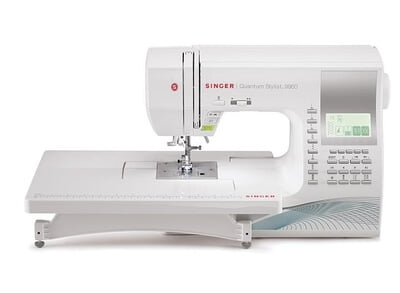 | Our Top Pick |
| Check Latest Price | |
Best Value
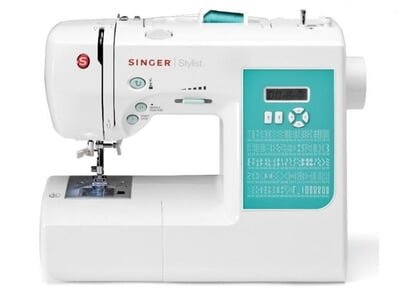 | Best Value |
| Check Latest Price | |
Powerful Sewing Machine
 | Powerful Sewing Machine |
| Check Latest Price | |
Heavy Duty Sewing Machine for Home Use
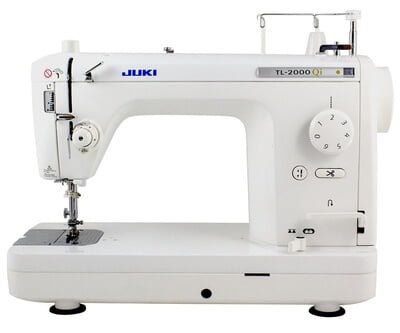 | Heavy Duty Sewing Machine for Home Use |
| Check Latest Price | |
Best Heavy Duty Sewing Machine for Leather
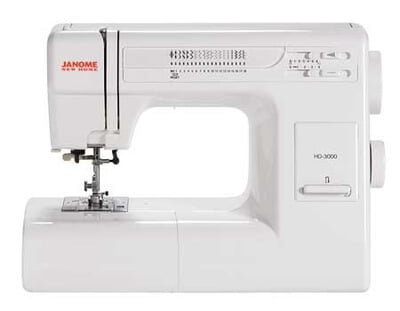 | Best Heavy Duty Sewing Machine for Leather |
| Check Latest Price | |
Solid Manual Machine
 | Solid Manual Machine |
| Check Latest Price | |
Basic Budget Machine
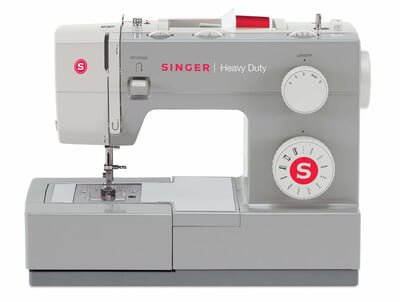 | Basic Budget Machine |
| Check Latest Price | |
Strong and Tough
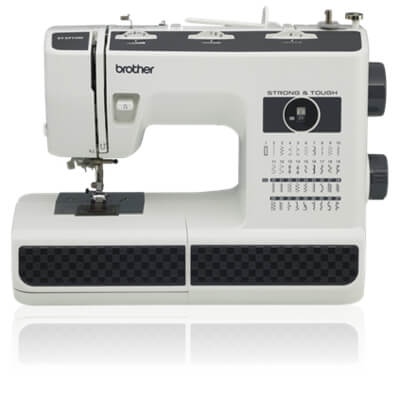 | Strong and Tough |
| Check Latest Price | |
Best Heavy Duty Sewing Machine for Denim
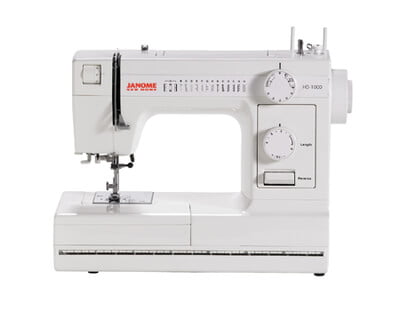 | Best Heavy Duty Sewing Machine for Denim |
| Check Latest Price | |
Best Budget
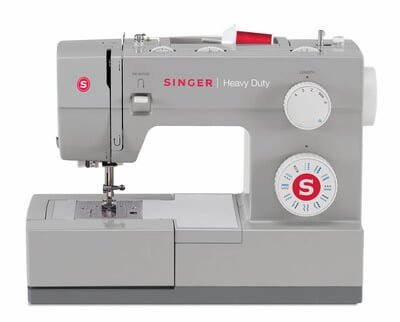 | Best Budget |
| Check Latest Price |
10 Best Heavy-Duty Sewing Machines for the Novice or Advanced Sewer
1. Singer Quantum Stylist 9960 Computerized Portable Sewing Machine – Best Heavy-Duty Sewing Machine for Home Use

This computerized sewing machine has it all. With over 600 customizable stitches, it’s got any stitch you might need – and plenty you don’t even know you need yet. In my opinion, this is the best heavy-duty machine for home use.
The Singer 9960 comes with an impressive 18 snap-on presser feet to handle any project: an all-purpose foot, a zipper foot, a button sewing foot, a satin stitch foot, a buttonhole foot (and underplate), an open toe foot, a blind hem foot, an overcasting foot, a narrow hem foot, a cording foot, a straight stitch foot, a darning and freehand embroidery foot, an even feed/walking foot, an adjustable bias binder foot, a single welt cording foot, a braiding foot, a clear piping foot, a “stitch in the ditch” fancy trim foot.
This machine also comes a handy extension table, extra needles, extra bobbins, spool pins and felt, screwdrivers, and a shank to make all those presser feet fit perfectly. The 600 built-in stitches are handily located on a diagram underneath the top cover, and there are also guides to help you wind the bobbin and thread the needle.
If you get lost, the helpful diagrams really come in handy. All of your stitches are located under the top cover, readily available (but out of sight). The alphanumeric stitch selections come with a “set it and forget it” functionality – just program them in and voila! Lettering!
The automatic needle threader and automatic thread cutter make switching between projects a breeze, and some of the stitches feature the ability for extra customization (mirroring, elongation, etc.).
What We Liked
What We Didn’t Like
To learn more about the Singer Quantum Stylist 9960 Computerized Portable Sewing Machine, click here.
2. Singer 7258 Computerized Sewing Machine – Best Heavy-Duty Sewing Machine for Beginners

The Singer 7258 is my personal favorite machine to look at – but it performs well too. Computerized but not complicated, this machine removes the guesswork that can come with fancy computerized machines. In my opinion, this is the best heavy duty sewing machine for beginners.
It has 100 built-in stitches – not too few, not too many. You can get to them easily, as there are only 3 buttons to handle the display. You can also program your needle to stop up or down, which is handy when working on quilting or adding appliques.
It’s light and portable, weighing in at only 13 pounds. This is a good machine for a beginner to bring to sewing class – all of the stitches are displayed right on the front of the machine. It also has plenty of handy diagrams to remind you how to wind the bobbin and thread the needle.
Included with this machine are a few extra presser feet: an all-purpose foot, a blind hem foot, a satin stitch foot, an overcasting foot, a darning and embroidery foot, a gathering foot, a rolled hem foot, and quarter-inch foot. It’s also got extra needles, spool pins, spool caps, bobbins, and a seam ripper and screwdriver.
The automatic bobbin winding stopper is really handy – especially for beginners. Nothing like overfilling a bobbin and having to start over!
What We Liked
What We Didn’t Like
If you want to find out more about the Singer 7258 Computerized Sewing Machine, you can read the whole review by clicking here.
3. Singer Heavy Duty 4432 Sewing Machine

The Singer 4432 is a versatile, uncomplicated, and powerful sewing machine. It’s simple enough for beginners to use, but it performs well for a more experienced sewer too. With an uncomplicated design and simple manual mechanics, the Singer 4432 is a good starter machine that can handle most projects.
It can speed through 32 different stitches at over 1,100 stitches-per-minute – the top of the range for home sewing machines. It also comes with 4 presser feet (an all-purpose foot, a zipper foot, a buttonhole foot, and a button-sewing foot) and standard sewing machine accessories (extra needles, bobbins, spool pins, and felt).
It can also handle thick fabrics such as canvas or denim, and has a simple and easy-to-use design. The clear bobbin cover makes it easy to see when things go awry, and the handy diagrams help novice sewers stay on the right path. Winding a bobbin or threading a needle takes some practice!
What We Liked
What We Didn’t Like
To learn more about the Singer Heavy Duty 4432 Sewing Machine, click here.
4. Juki TL-2000QI Sewing and Quilting Machine

The Juki TL-2000QI is one of the best heavy-duty sewing machine for home use. It’s the closest thing you’ll get to using an industrial machine, right from the comfort of your own living room.
It has a lightning-fast stitch speed at over 1,500 stitches per minute (most machines tap out at 1,100). It can speed through the thickest of fabrics, including denim or canvas.
The Juki TL-2000QI is more suited for an advanced sewer with very specific needs, rather than a beginner who is just beginning to dabble in the hobby.
It’s well suited for high-volume or quilting projects, due to the stitch speed, lockstitch design, and included extension table. It also has a handy knee lever, so you can raise the presser foot without using your hands.
This machine has a single lockstitch design, which means it only has one available stitch option. You can change the length of the stitches, but that’s about it.
However, it’s an extremely fast, extremely heavy-duty workhorse of a machine. If you’re planning to open a sewing business or spend more time sewing heavy projects than the casual sewer, this may be the machine for you.
What We Liked
What We Didn’t Like
Click here to find out more about the Juki TL-2000QI Sewing and Quilting Machine.
5. Janome HD3000 Heavy-Duty Sewing Machine – Best Heavy-Duty Sewing Machine for Leather

This is probably the best heavy-duty sewing machine for beginners. It has just the right amount of features to be useful and versatile, but not so many that it’s overwhelming. With 18 adjustable stitches, that’s usually plenty for most casual home sewers.
It features an adjustable pressure presser foot, which makes sewing over layers of folded fabric a breeze. Do you have growing kids and spend a lot of time hemming jeans? This is the machine for that.
The 7-point feed dog system keeps your fabric in place, and the automatic needle threader takes the guesswork out of threading that pesky needle.
The Janome HD3000 also comes with a few presser feet as well, including an all-purpose foot, a blind-stitch hem foot, a rolled hem foot, an overedge foot, a buttonhole foot, and an extra glide foot. It also has extra needles, bobbins, and a handy storage compartment to store them.
The Janome HD3000 is my personal choice when it comes to the best heavy duty sewing machine for leather, but make sure you’ve got fresh needles and the correct settings. Leather is unforgiving – the tiniest mistakes can be irreversible!
What We Liked
What We Didn’t Like
To learn more about the Janome HD3000 Heavy-Duty Sewing Machine, click here.
6. Singer Heavy Duty 4452 Sewing Machine

The Singer 4452 is a solid manual machine that can handle most projects you throw on it. With 32 built-in adjustable stitches, it has plenty of versatility without being too overwhelming for novice sewers.
It also has convenient features that make it a good choice including a built-in needle threader, stainless steel bedplate, and easy-to-load top drop-in bobbin. It also has a high adjustable presser foot to accommodate bulkier fabrics.
It comes with a few accessories as well, including an all-purpose foot, a zipper foot, a buttonhole foot, an even feed walking foot, and a nonstick foot. It also includes a seam ripper, extra needles, bobbins, spool pins and felt.
Performing at 1,100 stitches per minute, the Singer 4452 is on the higher end of home sewing machine speeds. If you’re looking for a basic machine to crank out those tote bags, consider this model.
This machine is great for the casual home sewer who occasionally needs to sew heavy fabrics. If you’re looking to sew constantly, you may want to consider a fancier upgrade.
What We Liked
What We Didn’t Like
To find out more about the Singer Heavy Duty 4452 Sewing Machine, click here.
7. Singer Heavy Duty 4411 Sewing Machine

The Singer 4411 is a basic budget machine that gets the job done. It has the bare bones of features, but it has a fast stitch speed (1,100 stitches per minute) and can still handle heavy-duty fabrics such as denim.
With only 11 stitch choices, it isn’t overwhelming, but it isn’t that impressive either. It’s a great machine for those who are new to sewing and unsure if they want to commit to a bigger, fancier machine.
It comes with four presser feet (the all-purpose foot, buttonhole foot, zipper foot, and button sewing foot), and your standard extra needles and bobbins.
The adjustable presser foot is handy for switching between heavy fabrics and delicate fabrics, and the adjustable needle positioner gives you three different position options for your needle.
What We Liked
What We Didn’t Like
To find out more about the Singer Heavy Duty 4411 Sewing Machine, click here.
8. Brother ST371HD Strong and Tough Sewing Machine

This tough little machine gets the job done. The Brother ST371HD is “strong and tough” and “heavy-duty” – it can handle thick fabrics with ease. It features a simple design with clear diagrams on the front, so you don’t have to go searching for your stitch selections.
There are handy dials on the top to adjust the length and width of your stitches and tension if you need to, and diagrams to make threading your needle simple. With a stitch speed of 800 stitches per minute and an automatic needle threader, this machine is beginner-friendly, but durable.
Accessories include 6 interchangeable feet: an all-purpose foot, nonstick foot, zipper foot, blind stitch foot, buttonhole foot, and a button-sewing foot. It also includes a removable accessory tray for the extra needles, bobbins, spool caps and spool pins, and screwdriver. You’ll have to store the handy instructional DVD separately.
It has 37 adjustable built-in stitches (which go up to 7mm in width) and a simple a 1-step buttonhole.
What We Liked
What We Didn’t Like
Click here if you want to learn more about the Brother ST371HD Strong and Tough Sewing Machine.
9. Janome HD1000 Heavy-Duty Sewing Machine – Best Heavy Duty Sewing Machine for Denim

This sewing machine is as tough as they come. Its solid heavy-duty metal construction can plow through thick fabrics with ease.
If you’re looking for a utilitarian workhorse, the Janome HD1000 gets the job done. This is one of the best heavy duty sewing machines for denim. It can even sew through a yardstick (not that there’s any need to do that, but it’s pretty powerful!).
With this model, you can lower the feed dogs for free-motion sewing. The 3-piece feed dog system keeps your fabrics running smoothly through the machine without jamming.
If you’re looking to crank out quilts and you only use a handful of stitches, this machine is a good choice. The automatic needle threader takes the strain off your eyes, too.
The Janome HD1000 has 14 utility stitches and a 4-step buttonhole. It also comes standard with an all-purpose foot, a zipper foot, a blind hemming foot, a sliding buttonhole foot, extra needles, bobbins, felt, screwdrivers, a hem guide, and a soft cover.
What We Liked
What We Didn’t Like
To learn more about the Janome HD1000 Heavy-Duty Sewing Machine, click here.
10. Singer Heavy Duty 4423 Sewing Machine

The Singer 4423 is my selection for the best sewing machine for your budget. If you’re looking for a nice, solid, beginner-friendly machine – it’s is a great choice.
It’s uncomplicated, it has a clean design, and it can handle most fabrics you throw on it. Whether you’re new to sewing, and just want to pull it out for the occasional costume or hem, or you’re a pro who needs an inexpensive backup – the Singer 4423 can handle it.
It has an automatic needle-threader and 23 adjustable stitch selections. With a high stitch speed of 1,100 stitches-per-minute and a heavy-duty frame, it can perform with the best of them – for a lower cost.
The adjustable presser foot is handy for switching between delicate fabrics and heavier fabrics, especially if you’re working on a variety of projects simultaneously. It also comes standard with an all-purpose foot, a zipper foot, a buttonhole foot, seam ripper, spool pin and felt, and extra needles.
If you want a solid machine that can get the job done and won’t cost you a fortune, consider the Singer 4423.
What We Liked
What We Didn’t Like
If you want to find out more about the Singer Heavy Duty 4423 Sewing Machine, click here.
Informative Heavy-Duty Sewing Machine Buying Guide
Regardless of which heavy-duty sewing machine you choose, there are a few things you’ll need to consider when making your selection. These helpful tips can save you time and frustration.
Things to Consider Before Making Your Heavy-Duty Sewing Machine Purchase
- Consider your projects. Think about what you plan on making with your machine, and how you intend to use it. If you’re planning to use it for hours every day, you’ll need a machine that can handle the volume and speed you’re looking for. If you only want to pull it out to make a costume now and then, you probably don’t need a big upgrade.
- Evaluate your skill level. While a beginner can learn to use even the most complicated of machines, try to find a good match for your skills. Decide if you’re really ready for a machine that has a ton of options, or maybe you want to master something more simple instead.
- Not all heavy-duty machines are created equal. While these heavy-duty machines can handle denim, canvas, and leather – make sure your specific machine can handle the volume of work you want it to do. Most of these machines are perfectly suited for casual home use, but if you’re looking to open up an industrial sewing operation, choose your sewing machine carefully.
- Don’t make it too complicated! If you’re easily frustrated by complicated machines, or you don’t have much hands-on experience with crafts or sewing, you’ll want to consider that before making a purchase. Just because a machine has all the bells and whistles doesn’t mean it’ll be the best for you. I find that simpler is better when you’re just starting out.
- Be patient. Learning how to sew is a process that takes time. Don’t try to rush it. Some machines have a bigger learning curve than others, so think about your level of patience for fiddly things when bringing home your machine.
Once You’ve Made Your Choice…
These tips can keep your machine performing at its best.
- Use fresh needles. Make sure your machine is set correctly for the project you want to do. Dull needles will lead to poor performance and frustration. Set yourself up for success!
- When in doubt, check the manual. If the answer isn’t in there, head to YouTube, where you can find tons of tutorials and solve virtually any problem.
- Select the correct stitch for the job. Check your tension, too. Most machines have some automatic settings to help you get started, but check the manual if you’re not sure.
- Keep your machine clean. Always clear debris and fabric scraps from your sewing area. On some machines, loose thread can fall into the bobbin area and turn everything into a jammed mess.
- Properly service your machine as needed. If you want your sewing machine to last a long time, take care of it. Keep the dust cover on, and don’t expose it to harsh conditions. These machines might be heavy-duty, but they have delicate mechanics!
- Use the correct bobbins and accessories. “Universal” accessories are not always universal. Make sure you’re using the correct class of bobbin for your machine, otherwise you could seriously damage it.
Quick Start Guide for Beginner Sewers
No two sewing machines are the same, and you’ll need a little know-how before throwing your first project on your machine. Here is a very basic quick start guide with the general order of operations.
- Unbox your machine and ensure it has all of its pieces, and hasn’t been damaged in some way. Unpackage your accessories, and set up your workspace.
- Read your manual! This can save you a lot of frustration and time down the road.
- Plug in the foot-pedal and turn the machine on.
- Wind and load the bobbin. If you’re unsure how to go about this (since every machine is a little bit different), check the manual or consult YouTube for a visual aid.
- Thread the top of your machine, and then your needle. Many of these machines have handy diagrams to help you remember which direction to go.
- Double-check your stitch settings. Make sure you’ve picked the right stitch for the job. You can always just start with a straight stitch if you’re just getting the hang of things.
- Test your machine with some scrap fabric. Better safe than sorry.
- Load your fabric under the needle, press down on the foot pedal, and off you go!
- If you experience any issues, check your manual for help. People tend to go wrong while winding the bobbin or threading the needle, until you get the hang of it.
Remember, all sewing machines have a learning curve. You’ll get it!
Final Verdict
No matter which sewing machine you eventually choose, the important thing is that you use it. There’s no point in buying something that’ll sit around collecting dust.
Make sure to weigh your options carefully against your personal crafting needs, as everyone has different preferences and abilities. At the end of the day, all of these machines have a learning curve – so don’t get frustrated if it takes you some time to learn your machine’s quirks.
My overall best pick is the Singer 9960. It has the most features for the price, and it performs well on a variety of fabrics. If you’re looking for a simple budget-friendly machine, the Singer 4423 strikes a good balance between function and cost. The Singer 7258 is an excellent value, and a good choice for beginners.
I recommend all of these machines for different reasons, so hopefully you’ve gained some insight into their features and benefits. With this comprehensive buyer’s guide, I know you’ll be able to choose the best heavy duty sewing machine for you!



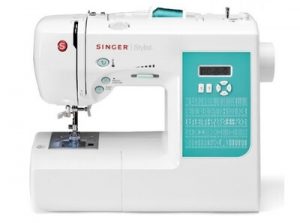
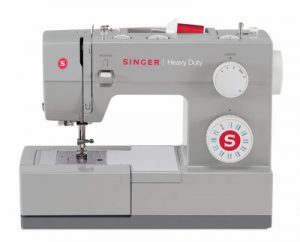


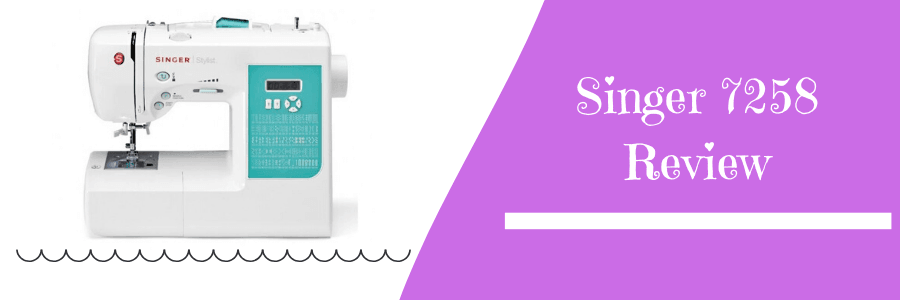
Great advice!
Thanks!